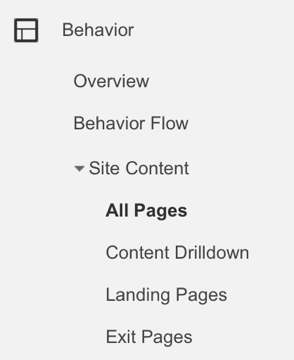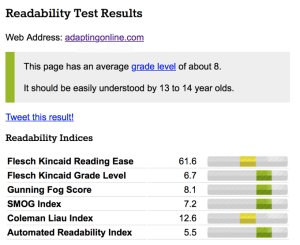3 Proven Ways to Reduce High Bounce Rates | Adapting Online
Your new site is finally live.
But after the excitement wears off you notice a major problem. Visitors are clicking the back button almost as soon as they arrive. And most rarely stay long enough to click through to your offer or browse other pages.
The problem?
High bounce rates.
Bounce rate refers to the percentage of visitors who leave without viewing other pages. So a bounce rate of 50% means that half of visitors are leaving after only viewing a single page. A number of reasons may be causing visitors to bounce from poor site design to usability issues.
Single page sessions could also mean visitors are:
- Calling your number to make an inquiry
- Getting your address for directions
- Clicking on an ad that leads to affiliate sales
- Filling out a form that doesn’t lead to a confirmation page
- Finding the information they need
A high bounce rate isn’t necessarily a bad thing. But it is an indication of less engagement with your visitors. So how do you reduce high bounce rates?
Start With Google Analytics
How do you know if your site suffers from a high bounce rate?
The first step is to check your Google Analytics. When you login to your account, you are presented with key information about your site. For more details about each page, click on Behavior on the left side. Then go to Site Content and All Pages.

Here you get details on page views, average visit duration, bounce rates, and even page values if you have conversion goals set. You can also see bounce rates for traffic sources to your site by clicking on Traffic Sources and All Traffic.
This information is incredibly valuable as it helps you determine:
- Which pages have the highest bounce rates
- What sources have the highest engagement
- Where to focus your efforts
The last point is the most important.
You initially want to look at bounce rates for pages with the most impact such as your homepage and landing pages for your products or services. These are pages with the highest potential value so it makes sense to start with these first for your internet marketing efforts.
What Causes High Bounce Rates?
Usability issues could be preventing visitors from accessing certain parts of your site or visitors could be leaving in frustration because of the slow loading times. Before you can take steps to reduce your bounce rate, it helps to first understand why visitors are leaving in such high numbers.
Here are common reasons for high bounce rates:
- Poor website design: Visitors typically decide within the first few seconds on whether to stay on a page. Pages cluttered with ads or poor structure leads to a negative user experience. There is absolutely no substitute for a quality website design.
- Slow loading times: Consumers have higher expectations than ever before and expect pages to load quickly. Visitors will not hesitate to quickly leave your site if it takes too long to load. Google has even made loading times a ranking factor in the search results.
- Untargeted traffic: Not all traffic sources are the same and some will be more targeted than others. This why it is helpful to look at bounce rates for different traffic sources so you can see which offers more value.
- No clear call to action: Another reason for high bounce rates is simply because it is not clear what the visitor should do. Whether you want visitors to make an online purchase, fill out a lead form, or subscribe to a newsletter, always include a clear call o action.
One of these issues is likely causing high bounce rates.
Your site could be losing potential customers from factors that are easily within your control. The next then is to reduce your bounce rate. Here we look at three proven ways to do exactly that and increase conversions at the same time.
1. Invest in a Quality Website Design
How a site looks matters.
It’s the reason why some of the largest companies in the world (e.g. Apple, Google, Amazon, etc.) invest heavily in their site design. Because consumers are quick to make judgments based on what they see. Poor designs are typically met with skepticism and mistrust.
Research from the Stanford Web Credibility Project confirms that visual design has a strong influence on first impressions. Nearly half of all consumers (46.1%) in the study assessed the credibility of a site based on its design including the layout and color schemes.
B.J. Fogg—experimental psychologist from the study—made the following conclusion:
“The truth of the matter… is that people do judge a web site by how it looks. That’s the first test of the web site. And if it doesn’t look credible or it doesn’t look like what they expect it to be, they go elsewhere. It doesn’t get a second test.”
The first few seconds of a visit are absolutely crucial.
The good news is you can establish credibility and build trust right from the start with a quality design. This is one part of your business you should never skimp on. There are services that make it easy design your own website with a template. But the problem is that thousands of other users are likely using the same designs.
Work with professional website designers to build a professional site that reflects your brand. The investment is well worth the cost and can result in even more conversions.
2. Improve Readability
Think about how you browse online.
Do you read every single word?
Probably not.
Research has shown that a majority of users scan new pages. This makes sense as users are constantly bombarded by new things vying for their attention. And most simply don’t have the time to read each new page in depth.
Put your site URL through the Readability Test Tool to measure its readability.
The indicator bars provide a visual representation of the readability of your text. Green means a higher score on readability while red means a lower score.
Improve the readability of your content with the following:
- Break up large blocks of text
- Use heading with relevant keywords
- Insert multimedia (e.g. images, videos, etc.)
- Use bulleted lists to facilitate reading
- Bold or highlight main ideas
- Remove any filler content
Each page should make it easy for visitors to find exactly what they are looking for. There is nothing more frustrating than having to zoom in on small text or be greeted with large blocks of text without any line breaks.
Even the best website design is rather pointless if it sacrifices readability.
3. Increase Page Load Times
You click (or tap) on a search result.
A few seconds go by. And then more.
But the page is still loading.
What would you do in this instance?
Studies have found that 40% will exit a web page if it takes longer than three seconds to load. Almost half of respondents in the survey (47%) reported that they expect pages to load in two seconds or less. Any longer and you can expect visitors to quickly bounce out.
Just as a professional design is important, the same can be said for loading times. No one wants to wait more than a few second for your site to load when they could easily hit the back button and click on a different result.
Use PageSpeed Insights to analyze the performance of your site. You even get suggestions to improve loading times for both the mobile and desktop versions of your site:
Make site loading times a priority to reduce bounce rate.
Conclusion
High bounce rates are an indication of less engagement with your visitors.
Anything from poor design to usability issues could be causing visitors to quickly leave without viewing other pages. Take steps to reduce a high bounce rate by investing in a quality website design, improving content readability, and optimizing loading times. Doing so can make a huge difference to your bottomline.


